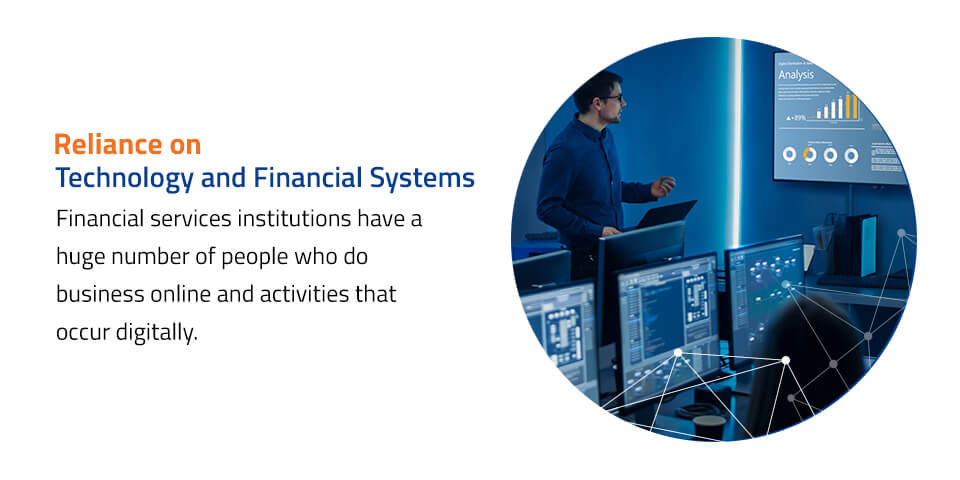Ransomware is a growing threat to businesses and institutions worldwide, increasing in frequency and cost. In 2022, 71% of organizations worldwide were victimized by ransomware, up from just over 55% in 2018. Financial services institutions are particularly at risk of being targets in these attacks. The volume and value of a financial service organization’s data are attractive targets for ransomware criminals. These institutions store and handle significant quantities of personal information and have numerous entry points for an attack.
Although financial institutions are vulnerable to the threat of ransomware, they can take steps to mitigate the risk. Learn about the dangers of ransomware for your financial institution and how to prevent an attack.
What Is Ransomware in Financial Services?
Ransomware in financial services is a type of cybersecurity attack involving malware that attacks and encrypts files within a financial service institution’s network. Ransomware is a type of malware that encrypts and holds hostage files on a device. The ransomware renders the files and potentially the computer unusable, and the attacker demands a ransom in exchange for restoring the data. Ransomware in financial services specifically targets financial services institutions like banks, credit unions, financial advisors, insurance companies and more.
Ransomware attacks on financial institutions are serious and prevalent. A recent report found that ransomware attacks on financial services organizations in America increased to 55% in 2021, up from 34% in 2020. The average cost of remediation in the industry was $1.59 million, higher than the $1.4 million global average. One of the most significant recent ransomware attacks on financial institutions in the United States was the attack on insurance firm CNA Financial, which exposed the personal information of over 75,000 people.
The Impact of Ransomware on Financial Institutions
Ransomware has the potential to significantly harm a financial institution’s data integrity, reputation and finances. Consider the dangers of ransomware in this industry:
Lost Access to Critical Systems and Data
One of the most significant threats of a ransomware attack is the loss of access to critical financial systems and data. A ransomware attack could target one of the institution’s vendors — such as call centers, online banking systems or cloud providers — and gain access to their broader infrastructure. From there, cybercriminals can severely limit an organization’s operations. For example, a ransomware attack on a bank may result in encrypted and unusable financial data, crippling the institution’s employee and customer services and business continuity.
Financial Losses
Financial institutions that are victims of ransomware attacks often suffer heavy monetary losses. Although paying a ransom does not guarantee that a financial institution will receive its decrypted files or remain free from another ransomware attack, many institutions feel it is their only option. According to reports about the ransomware attack on CNA Financial, the company paid $40 million in ransom. While the Cybersecurity and Infrastructure Security Agency recommends not paying ransoms, some still do. The costs of business interruption can also be high.
Damage to the Institution’s Reputation
Reputational damage may be unseen but can still significantly impact a financial services institution’s health. Customers who have had their personal information stolen through a ransomware attack on a financial institution may no longer trust the institution and take their business to another company. The institution’s share prices may also decline due to negative publicity, especially if it is found that the institution failed to follow data security protocols.
The Reasons Why Ransomware Is Particularly Dangerous for Financial Institutions
Ransomware is one of the most severe cyber threats to organizations in financial services. While other industries are also at high risk, financial institutions have specific characteristics that make them appealing to cybercriminals planning a ransomware attack. Here are a few reasons why ransomware attacks on financial institutions are particularly dangerous:
Sensitive Financial Data
Financial services institutions handle sensitive personal and financial data for their customers and clients. Much of this information is stored electronically, making it a possible target for a ransomware attack. Financial services organizations store data such as:
- Credit card numbers
- Savings and checking account numbers
- Social Security numbers
- Wills
- Titles
- Estate documents

Reliance on Technology and Financial Systems
Financial services have increasingly adopted digital and cloud-based systems for their daily operations. For example, the percentage of Americans using digital banking rose from 2018 to 2022. Financial services institutions have a huge number of people who do business online and activities that occur digitally. These institutions also tend to work with multiple vendors, from software to banking equipment vendors, all of which could have access to customer data.
Financial institutions have a broad attack surface because of this reliance on technology. The enormous flow of information through a financial institution’s systems presents a challenge to securing and protecting its data.
Potential Disruption to Financial Markets
Ultimately, a ransomware criminal’s motivation for attacking a financial services institution comes down to money. Banks and other financial institutions consistently handle up to millions or trillions of dollars, making them prime targets for criminals interested in enormous payouts. While businesses in different industries also handle large sums of money, financial institutions provide ransomware criminals multiple opportunities for profit.
Steps Financial Institutions Can Take to Prevent Ransomware Attacks
Ransomware is a threat your financial services institution should take seriously. While the likelihood and severity of ransomware attacks on financial institutions have increased, institutions have strategies available to help them prepare for and prevent a ransomware attack. Understanding the nature of the threat can help your institution safeguard its critical data and protect itself from risk.
Here are a few steps that can prevent ransomware attacks on financial institutions:
Implementing Strong Cybersecurity Measures
It is more essential than ever for financial services institutions to put effective cybersecurity measures in place to protect their systems and data. For example, following an IT security checklist helps your institution ensure it takes every effort to prevent a security compromise. This may include steps such as:
- Assessing vendor risk and strengthening vendor security
- Installing file-access restrictions
- Implementing firewalls and anti-malware
- Patching and updating outdated systems
Training Employees to Recognize and Avoid Ransomware Threats
Another essential step financial services institutions should take to protect their data is training employees in cybersecurity best practices. Ransomware is frequently spread through phishing emails, which mimic trusted stakeholders to solicit sensitive information from employees. Training employees to recognize phishing schemes and report them can help your institution avoid a number of these attacks.
Developing a Response Plan in Case of an Attack
Implementing cybersecurity measures and training employees to recognize and avoid ransomware attacks are helpful methods for preventing an attack. However, businesses can’t prevent every attack, as ransomware constantly evolves. Develop a ransomware response plan in case of an attack to ensure your institution isn’t caught off guard.
Invest in robust disaster recovery solutions and conduct frequent vulnerability tests to spot weaknesses before ransomware attackers exploit them. Avoid paying the ransom and report the attack to the proper authorities within at least 36 hours, as the Federal Deposit Insurance Corporation (FDIC) requires.

Find the Best Cybersecurity Solutions From Morefield
Institutions in the financial services industry must prioritize cybersecurity to protect themselves and their customers from the consequences of ransomware attacks. These attacks can devastate institutions and their clients, leading to financial and reputational damage.
Morefield has decades of experience developing best-in-class IT solutions that are cost-effective, reliable and comprehensive. Our IT services for financial services institutions include security, unified communications and fully managed IT and networking. With over 75 years of industry experience, we have the experience and skills to optimize your systems while complying with industry regulations and providing exceptional customer service. Reach out to our IT experts to talk about your cybersecurity needs and find the best solution.
